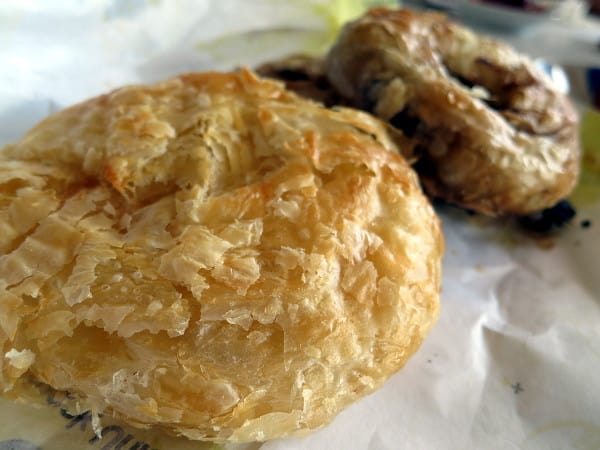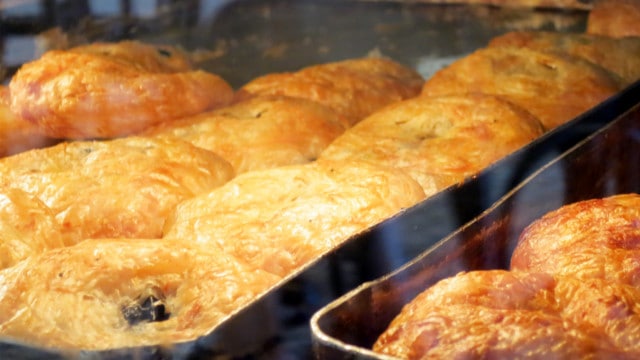For visitors to Izmir from other parts of Turkey, morning may herald momentary confusion. Instead of hearing the cries of the simitçi, some hoarse-voiced fellow will be walking the streets with a cart and shouting offers of “gevrek!” But not to fear, non-Izmirlis, gevrek is simply the local version of simit, the sesame-covered Turkish breakfast pastry of choice. This being Izmir, however, one will probably also hear a completely different word wafting through the window, one unlikely to be heard from street sellers anywhere else in the country: “boyoz”.
This round, flaky pastry is the saving grace of Turkish baked goods, if, like some of us, you find tough, dry, or crumbly things inedible. Sure, eating one can be a bit messy, with flakes dropping all over the place – but it does beat choking to death. The light, crispy layers of well-made boyoz give way to a soft, slightly chewy inside, that may or may not contain a filling, such as cheese, minced meat or even chocolate. The plain variety is often sliced open and stuffed with egg, tomato and cheese. Frankly, anyone who doesn’t like boyoz is probably doing it wrong. Either they are eating them cold (don’t), or they are eating them somewhere other than Izmir (unfortunately, the boyoz I’ve found in Istanbul just isn’t the same).

A reminder of Izmir’s multicultural heritage
The history of boyoz begins with the arrival in the Ottoman Empire of the Sephardic Jews, who were expelled from Spain in 1492. Offered refuge by Sultan Bayezid II, many found their way to Izmir (then known as Smyrna, “pearl of the Aegean”) and settled there, adding to the rich cultural mix of the city, which by the 17th century was home not only to Turks, but Armenians, Greeks, and Levantine Europeans.
The name boyoz is derived from bollos, meaning “buns” or “scones” in Spanish. While there are variants of the pastry in many places around the world where the Jewish immigrants settled, the Izmir boyoz is unique and truly a product of the cultural melting pot the city was in the past. The recipe originated with the Spanish Jews and was a different product from that we see today, with an envelope-like folded dough surrounding the traditional fillings of eggplant and cheese. The locals put their own spin on this, and were in turn influenced by master bakers from the Balkans, resulting in the modern boyoz – a rounded pastry made in batches, with a dough of flour, oil and a touch of tahini.
This style of boyoz has only been in existence for around 70 years, since commercial production began, and would be difficult to replicate at home, as the process involves throwing and spinning the large round of dough in the air, much like for pizza. Boyoz was then (and still largely is) a street food. All the boyozcu would buy pastries from the bakeries then carry them to the streets, congregating in the area near the ancient agora. These boyoz were often eaten alongside a cup of sübye, a milky drink made from crushed melon seeds.
Boyoz today
On my last trip to Izmir, much of this intriguing information was related to me by the corporate communications manager for Alsancak Dostlar Fırını (ADF), probably the city’s foremost producer of boyoz today. The company was established in 1983, its founder Mustafa Akar carrying on the traditions passed down by the master bakers of yesteryear. The Alsancak branch in central Izmir is still located at the same site today. While the bakery was originally situated on the floor above the cafe, it is now in a separate location in a nearby street. Today the upper floor gives a nod to the past, with a display of photos and information about boyoz around the seating area.
With the passing of Akar in 2009, his daughter Berrin Akar Rasuli continued to run the business and expand the product line. Since re-branding and renovating in 2014, they have gone beyond the traditional plain and spinach fillings to produce new and unusual flavors. There are currently 18 different types of boyoz on the menu, although some are only available seasonally. Other than the plain boyoz, the most popular flavors are chocolate and tahini. And to drink alongside, they serve not only tea, but sübye and delicious home-style lemonade.

In the last three years, two more branches of Alsancak Dostlar Fırını have been established, and while it may expand further within Izmir, there are no current plans to open elsewhere in Turkey. So you’ll just have to go to Izmir to experience the deliciousness! If you can’t do that, they do send frozen boyoz to some cities (like Istanbul) that can be reached by kargo delivery service within a day. Afiyet olsun!
All photos courtesy of the author.










[…] We did miss out on going to any meyhane (live bars). But on the other hand, we got to have some boyoz, a distinctively Sephardic food which has become widespread and mainstream (only) in […]